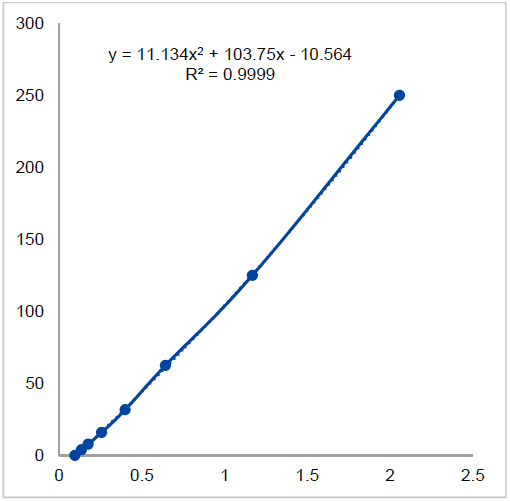IL-36gamma (human) ELISA Kit
| Code | Size | Price |
|---|
| AG-45B-0008-KI01 | 96 wells | £550.00 |
Quantity:
Prices exclude any Taxes / VAT
Overview
Regulatory Status: RUO
Target Species: Human
Shipping:
Blue Ice
Storage:
+4°C
Images
Further Information
Alternate Names/Synonyms:
Interleukin-1 Family Member 9; IL-1F9
Assay Type:
Sandwich
Detection Type:
Colorimetric
EClass:
32160000
Handling Advice:
After standard reconstitution, prepare aliquots and store at -20°C.Avoid freeze/thaw cycles.Plate and reagents should reach room temperature before use.
Long Description:
ELISA Assay. Detects natural and recombinant human IL-36gamma. Colorimetric assay. Sample Type: Cell Culture Supernatant, Serum. Range: 3.9 to 250pg/ml. Sensitivity: 3pg/ml. IL-36alpha (IL-1F6), IL-36beta (IL-1F8) and IL-36gamma (IL-1F9) are members of the IL-1 cytokine family that bind to IL-36R (IL-1Rrp2) and IL-1RAcP, activating similar intracellular signals as IL-1 and are inhibited by IL-36Ra. The expression of IL-36 cytokines occurs mainly in the lung and skin and can be derived from diverse epithelial cell types including keratinocytes, bronchial epithelium as well as macrophages, monocytes and different T cell subsets. IL-36 family members induce the production of pro-inflammatory cytokines, including IL-12, IL-1beta, IL-6, TNF-alpha and IL-23, thus promoting neutrophil influx, dendritic cell (DC) activation, polarization of T helper type 1 (Th1) and IL-17-producing T cells (alphabeta T cells and gammadelta T cells) and keratinocyte proliferation. Induction of IL-36gamma in macrophages upon M. tuberculosis infection and its role in the release of antimicrobial peptides has been proposed. IL-36gamma is also induced in the lung in various models of asthma and can be produced by bronchial epithelial cells in response to viral infection, smoke or inflammatory cytokines and plays an important role in asthmatic pulmonary inflammation. IL-36gamma might be a potential biomarker of Inflammatory Bowel Disease and is highly expressed in inflamed skin from psoriasis patients and in Allergic Contact Dermatitis. IL-36gamma serum levels are enhanced and correlate to psoriasis severity and response to treatment with anti-TNF.
Package Type:
Box
Product Description:
IL-36alpha (IL-1F6), IL-36beta (IL-1F8) and IL-36gamma (IL-1F9) are members of the IL-1 cytokine family that bind to IL-36R (IL-1Rrp2) and IL-1RAcP, activating similar intracellular signals as IL-1 and are inhibited by IL-36Ra. The expression of IL-36 cytokines occurs mainly in the lung and skin and can be derived from diverse epithelial cell types including keratinocytes, bronchial epithelium as well as macrophages, monocytes and different T cell subsets. IL-36 family members induce the production of pro-inflammatory cytokines, including IL-12, IL-1beta, IL-6, TNF-alpha and IL-23, thus promoting neutrophil influx, dendritic cell (DC) activation, polarization of T helper type 1 (Th1) and IL-17-producing T cells (alphabeta T cells and gammadelta T cells) and keratinocyte proliferation. Induction of IL-36gamma in macrophages upon M. tuberculosis infection and its role in the release of antimicrobial peptides has been proposed. IL-36gamma is also induced in the lung in various models of asthma and can be produced by bronchial epithelial cells in response to viral infection, smoke or inflammatory cytokines and plays an important role in asthmatic pulmonary inflammation. IL-36gamma might be a potential biomarker of Inflammatory Bowel Disease and is highly expressed in inflamed skin from psoriasis patients and in Allergic Contact Dermatitis. IL-36gamma serum levels are enhanced and correlate to psoriasis severity and response to treatment with anti-TNF.
Range:
3.9 to 250pg/ml
Sample Type:
Cell Culture Supernatant, Serum
Sensitivity:
3pg/ml
Specificity:
Detects natural and recombinant human IL-36gamma.
Transportation:
Non-hazardous
UNSPSC Category:
ELISA Kits
UNSPSC Number:
41116126
Use & Stability:
12 months after the day of manufacturing. See expiry date on ELISA Kit box.
References
IL-36gamma drives skin toxicity induced by EGFR/MEK inhibition and commensal Cutibacterium acnes: T.K. Satoh, et al.; J. Clin. Invest. 130, 1417 (2020) | Macrophage Phenotypes in Lung Fibrosis: C.K. Koss; Diss. Univ. Konstanz (2021)



